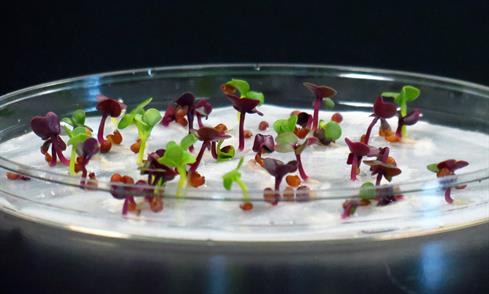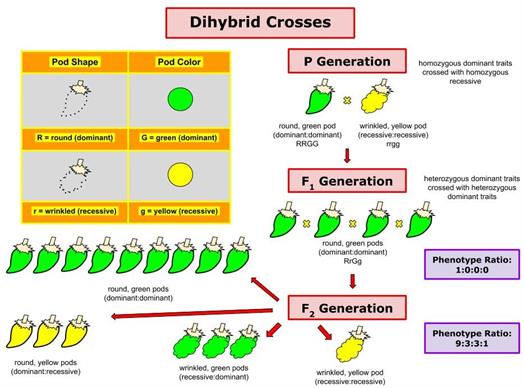PDF chapter test TRY NOW
In the previous object, we have learned about the inheritance of traits in monohybrid and dihybrid cross and the ratio at which the traits are expressed. This object discusses how do these traits get expressed. How does the mechanism of heredity work?

Green and purple seedlings
The above picture is an experiment conducted at a laboratory showing green and purple seedlings in a petri dish on a culture medium. These seedlings are fast-growing Wisconsin plants that can illustrate the Mendel dihybrid experiment. The purple colour of the plant is due to the presence of the pigment called anthocyanin, which is not present in the green colour plant. Also, green plants length is more than that of a purple plant.
For instance, let's have a look at the characteristic trait "tallness of the plant". The secretion of a particular plant hormone determines the tallness of the plant. If that particular plant hormone is secreted more, then the plant will be taller. If the secretion of the plant hormone is less, then the plant will be dwarf.
This plant hormone secretion is controlled by a particular enzyme, which is made up of specific proteins. Cellular \(DNA\) has the information for making such proteins in the cell. A section of \(DNA\) provides information for one such protein called the gene, which gives information to the enzyme.
If the enzyme responsible for the secretion of plant growth hormone works efficiently, then secretion of the plant hormone will be more, causing the plant to grow tall. But if the gene for the enzyme has an alteration, then the enzyme works less efficient, which will reduce the secretion of the plant growth hormone. This reduction in plant hormones makes the plant grow dwarf.
If the interpretations of Mendelian experiments we've been debating are correct, then both parents must contribute equally to the \(DNA\) of their offspring during sexual reproduction. If both parents can influence the trait in their offspring, they must be carrying a copy of the same gene. That is, each pea plant must have two sets of all genes, one from each parent.
A germ cell is any biological cell that produces gametes in a sexually reproducing organism.
All cells in the body have two sets of all genes. Contrary to all the cells of the body, germ cells have only one set of genes.
How can germ cells create a single set of genes from the two copies seen in every other cell in the body?
Since germ cells have one set of genes, progeny gets two sets of all genes.
\(\text{One set of all father genes }\) \(+\) \(\text{One set of all mother genes }\) \(\xrightarrow{\small{\text{}}}\) \(\text{Two sets of all genes in offspring}\)
If progeny receives a single whole set of genes from each parent, then the experiment won't work.
\(\text{Two sets of all father genes }\) \(+\) \(\text{Two sets of all mother genes }\) \(\xrightarrow{\small{\text{}}}\) \(\text{Four sets of all genes in offspring (Not possible)}\)
Example:
Consider a pea plant with round-shaped (\(RR\)) and green coloured seed (\(yy\)) and another pea plant with wrinkled shaped (\(rr\)) and yellow coloured (\(YY\)) seed.
If we consider purebred parental forms, then
- A round-shaped seed plant has \(RR\), two dominant genes.
- A green-coloured seed plant has \(yy\), two recessive genes.
- A wrinkled-shaped seed plant has \(rr\), two recessive genes.
- A yellow-coloured seed plant has \(YY\), two dominant genes.
If both the pea plants are fertilised, then in the \(F1\) generation, we will see all the plants with round shaped and yellow coloured seeds. But if we see the genotypic expression, the \(F1\) generation has:
- Both round-shaped gene and wrinkled-shaped genes; indicated as \(Rr\)
- Both Yellow and green-coloured genes; indicated as \(Yy\).
Since round and yellow are the dominant characteristics of the pea plant, the \(F1\) generation exhibits them. Even though wrinkle-shaped and green-coloured genes are also present in \(F1\) generation plants; they are not exhibited and are called recessive traits.

Dihybrid crosses based on seed colour and seed shape
You can see in the \(F1\) generation, a whole set of genes from the parents are not transferred to the progeny.
\(\text{RRyy (Parent 1) }\) \(+\) \(\text{rrYY (Parent 2)}\) \(\xrightarrow{\small{\text{}}}\) \(\text{RrYy (Progeny)}\)
If you see the above process, we can say the gene sets \(RR\), \(yy\) in parent 1, and gene sets \(rr\), \(YY\) in parent \(2\) are independent.
Each gene set is present as discrete independent pieces; each is called a chromosome rather than a single lengthy thread of DNA. As a result, each cell will have two copies of each chromosome, one from each parent. Each pair of chromosomes will be taken by each germ cell, and these chromosomes may be maternal or paternal in origin. When two germ cells merge, the number of chromosomes in the progeny returns to normal, ensuring the species' \(DNA\)'s stability. All sexually reproducing creatures use this type of inheritance mechanism, which explains the results of Mendel's research. Asexually reproducing species, on the other hand, follow identical inheritance processes.
Reference:
https://commons.wikimedia.org/wiki/File:Dihybrid_Cross_of_Pea_Plants.jpg
